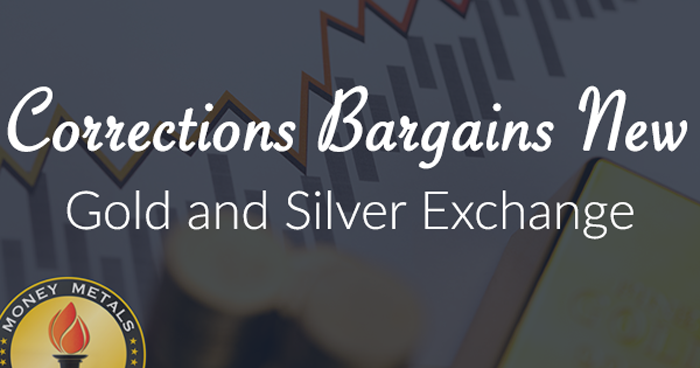The past week was marked by volatility and a sharp sell-off in both gold and silver during the middle of the week.
Gold spot prices ultimately lost $60 (-3.4%) for the week to close at $1,713/oz. Silver closed down $0.62 (-1.7%) on the week, finishing at $34.80. Platinum and palladium held up better, with platinum closing down just $14 at $1,704 and palladium closing essentially unchanged for the week at $722/oz.
Price Volatility Is the Norm
The precious metals markets are volatile. This has been especially true since currencies worldwide became untethered from gold and silver, and a highly leveraged futures market became the mechanism for price discovery. The massive flows of money in and out of these relatively small (but highly leveraged) markets can result in sudden price movements.
These factors appear to be responsible for the volatility we saw this week. After rallying to intermediate highs last week, gold lost nearly $100 on Wednesday alone and silver fell almost $4 intra-day, before bouncing back some.
The price declines appear to have been triggered by futures selling by leveraged players just as Chairman Bernanke gave his report to Congress. Bernanke argued that economic fundamentals are slightly improving and downplayed the need for more monetary easing in the near future. Overall, Bernanke's comments were mildly bearish for short-term gold and silver prices, as speculative traders and momentum players in the futures markets backed off their bets of near-term Federal Reserve stimulus.
What wasn't widely reported on Wednesday is that the European Central Bank made just over $700 billion in dollar-equivalent loans to about 800 banks at 1% interest and accepted a pile of dubious assets as collateral.
Short Sellers Pounce on Metals Market After Fed Chairman's Remarks
And while Bernanke was talking to Congress, a very large player in the futures market dumped 10,000 gold contracts (representing 1,000,000 ounces). The spot price fell $30 almost instantly and produced the familiar negative cycle. Lower prices progressively triggered stop loss orders and margin calls while encouraging computer-driven algorithmic selling. (High-frequency or machine-driven trades now represent a significant portion of the activity in futures markets.) The net result: paper gold prices down $100 in a matter of a couple hours.
Who is responsible for dumping all those contracts isn't publicly known. Possible explanations are that it was just an opportunistic effort to generate profits on a massive short position or that it was a coordinated intervention aimed at slowing the advance of gold (and silver) prices, which have risen almost uninterrupted since Jan. 1st.
Regardless, Money Metals Exchange customers have demonstrated they are unfazed by the games being played in the futures market. Years ago, this sort of price action would have had people running for their phones and calling their bullion dealer to sell. Now we are seeing the opposite reaction.
Similar to the pattern we saw during market corrections in 2011, people calmly recognized the opportunity and walked to their phones to buy. Money Metals Exchange was flooded with buy orders after last week's correction.
New Price Discovery Mechanism for Silver May Be Near
Ned Naylor-Leyland of Cheviot Asset Management announced on Friday that an alternative to the Comex and LBMA exchanges is nearly ready to launch in China. This exchange is a potential "game changer" when it comes to how the market price for physical bullion is established.
Currently, the spot price for physical metals is generated in futures markets where at least 100 ounces of paper metal is traded for every physical ounce that is actually available for possession. This mechanism produces volatility, such as we saw last week. It also presents an opportunity for large players to manage prices artificially with tactics such as naked shorting (selling metal they don't own to force prices lower).
This new market promises 100% metal backing on every contract traded. It should make the price discovery process for physical metal more stable and more honest.
At the moment, the backers of this new Asian exchange are keeping details very close to the vest, but Money Metals Exchange expects to be able to report more developments about this important subject over the next couple of months.
Premiums & Buying Trends
Physical buying activity edged up substantially from prior weeks, and the relatively quiet conditions we saw throughout the first two months of the year may be giving way to more sustained and heavier volume. Time will ultimately tell if this level will be sustained. Customer selling was again virtually non-existent.
Premiums were relatively unchanged throughout the week, but many gold premiums fell as the week closed. Silver premiums are virtually unchanged, although pre-1965 90% coins have crept up ever so slightly from the extremely low levels of last week.
In a change of pace from the norm, gold sales far exceeded silver sales this past week at Money Metals, mainly due to our fantastic sale on Australian Gold Kangaroos. Scores of customers "hopped" on the opportunity to buy one-ounce gold Kangaroos at both a spot price markdown (thanks to the week's price correction) plus a discounted premium offered to our customers.
We Buy Back Too!
We want customers to know that Money Metals Exchange is here to buy back gold, silver, platinum, and palladium in the common bullion forms. We certainly don't advocate selling at this time, as we think the bull market in metals has years left to run. However, if you decide to sell for whatever reason, we can lock a price with you right over the phone, deliver a purchase order to confirm the transaction, and send your payment promptly after we receive the metal. You will find we are as easy to deal with when you sell as we are when you buy!
Call Money Metals Exchange to Buy or
Sell Precious Metals Coins, Bars, and Rounds.– 1-800-800-1865.

About the Author:
Clint Siegner is a Director at Money Metals Exchange, a precious metals dealer recently named "Best in the USA" by an independent global ratings group. A graduate of Linfield College in Oregon, Siegner puts his experience in business management along with his passion for personal liberty, limited government, and honest money into the development of Money Metals' brand and reach. This includes writing extensively on the bullion markets and their intersection with policy and world affairs.





